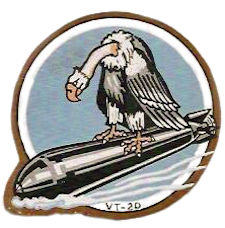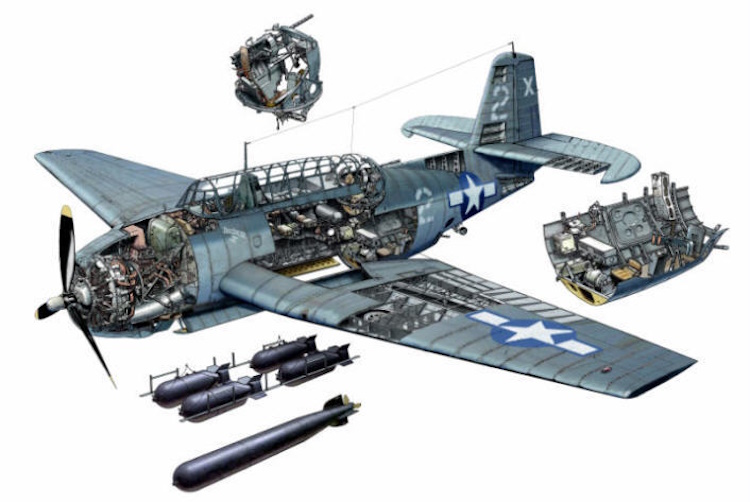Origins Of The TBM Avenger
The Grumman TBF-1 Avenger, designated TBM Avenger when produced by General Motors, was developed for the US Navy and Marine Corps as a torpedo bomber during World War II. Despite early challenges, such as setbacks at the Battle of Midway, the Avenger became an effective aircraft with improved American air superiority, better attack coordination, and experienced pilots. Besides attacking surface ships, TBM-1 Avengers excelled in anti-submarine warfare, sinking around 30 submarines, including the notable I-52 cargo submarine. They played a crucial role in both the Pacific and Atlantic theaters, protecting Allied convoys and deterring German U-boats.

A TBM-1C Avenger of Torpedo Twenty traps aboard USS Enterprise (CV-6) 10 October 1944
World War II Service
TBM Avenger aircraft significantly impacted the Pacific and Atlantic theaters during World War II. They were instrumental in deterring German U-boats and providing air cover for Allied convoys, enhancing maritime safety. Avengers contributed to the sinking of the Japanese battleships Yamato and Musashi. They served well beyond the war, with various modifications extending their operational life into the 1960s. The Avenger was used by 10 different nations and had up to 49 variants. The TBM-1C Avenger of Torpedo Twenty, for instance, played a vital role aboard the USS Enterprise (CV-6) in October 1944.
Torpedo Twenty (VT-20) and the TBM-1 Avenger
VT-20, known as the Vultures of Torpedo Twenty, flew the TBM Avenger throughout WWII, earning the Presidential Unit Commendation, Asiatic-Pacific Campaign Medal, several battle stars as well as individual awards such as the Navy Cross and Silver Star. The Vultures participated in numerous campaigns in the Pacific. Notable actions include strikes against Chichi Jima, the Palau Islands, Okinawa, Formosa, Luzon, and the Battle of Leyte Gulf. VT-20’s TBM-1C Avengers contributed to the sinking of the Japanese battleship Musashi and received multiple awards for their actions, highlighting their significant contributions during the war.
VT-20 deployed on the USS Enterprise (CV-6) and USS Lexington (CV-16) and participated in several campaigns in the Pacific

VT-20 (Torpedo Twenty) Squadron Patch
1 Sep 1944: The squadron’s first combat action involved strikes against shore installations on Chichi Jima in the Bonin Islands.
Sep 1944: Squadron aircraft participated in strikes against Palau Islands in preparation for and support of the landings on Peleliu Island.
Oct 1944: The squadron participated in strikes against Okinawa, Formosa and Luzon in preparation for and support of the landings on Leyte.
15 Oct 1944: Lieutenant Edward B. Holley, flying a squadron TBM, shot down a Zero, Mitsubishi A6M fighter, over Luzon.
24 Oct 1944: The squadron participated in the Battle for Leyte Gulf. VT-20’s TBM-1C Avengers flew sorties against a powerful Japanese surface force in the Sibuyan Sea. These attacks contributed to the sinking of the mighty Japanese Battleship Musashi, one of the two largest battleships in the world.
The following squadron personnel were awarded the Navy Cross for their action against the Japanese task force: Ensigns W. T. Ross, W. J. Schaller, and G. Swint III; Lieutenant (jg) M. Throwbridge; Lieutenants C. H. H. Dickey, E. B. Holley, and R. E. McHenry, and Lieutenant Commander S. L. Prickett.

TBF Avenger dropping a torpedo
25 Oct 1944: Squadron aircraft were part of the Fast Carrier Task Force that attacked the Japanese carrier force in the Battle of Cape Engano. Four Japanese carriers were sunk during this engagement. The following squadron personnel were awarded the Navy Cross for their action during the Battle of Cape Engano: Ensigns T. E. Armour, J. L. Baxter, M. H. Krouse, and C. D. Leeper; Lieutenant (jg)s P. H. Bradley and C. F. Schlegel; and Lieutenants J. H. Howell, Jr., M. L. Leedom, E. E. Rodenburg, and R. J. Savage.
Nov 1944: The squadron participated in strikes against a Japanese troop convoy in Ormoc Bay, Leyte and enemy positions on Luzon.
Dec 1944: Strikes were flown against Luzon in preparation for the landings at Lingayan Gulf, Luzon.
Jan 1945: Squadron aircraft flew strikes against Luzon, Formosa, Hong Kong, Japanese convoys in South China Sea and along coast of French Indochina, and Okinawa.
12 Jan 1945: Lieutenant J. N. Howell, Jr and Lieutenant (jg) M. Throwbridge were awarded the Silver Star Medal for their action against a Japanese cruiser that was protecting a convoy off the coast of French Indochina. Their attacks contributed to the sinking of the cruiser.

Japanese aircraft carrier Zuihō pictured from a VT-20 TBM during the Battle off Cape Engaño, October 1944
TBF Avenger/TBM Avenger Specifications
The Grumman TBM-1 Avenger had a three-member crew: pilot, turret gunner, and radioman/bombardier/ventral gunner. It was armed with a nose-mounted .30 caliber machine gun, a rear-facing .50 caliber turret gun, and a ventrally-mounted .30 caliber machine gun. Later models replaced the cowl-mounted gun with twin .50 caliber wing-mounted guns. The aircraft could carry various payloads, including a Mark 13 torpedo or up to four 500-pound bombs. With a 30,000 ft ceiling and a 1,000-mile range, the TBM-1 Avenger surpassed previous American torpedo bombers and its Japanese counterpart in performance.
General Characteristics
Crew: 3
Length: 40 ft 1⁄8 in (12.195 m)
Wingspan: 54 ft 2 in (16.51 m)
Width: 19 ft (5.8 m) folded
Height: 16 ft 5 in (5.00 m)
Wing area: 490 sq ft (46 m2)
Gross weight: 15,536 lb (7,047 kg)
Fuel capacity: Fuel 330 US gal (275 imp gal; 1,249 L) in three center-section integral tanks + 2x 58 US gal (48 imp gal; 220 L) droppable slipper tanks under outer wings, with provision for a jettisonable 275 US gal (229 imp gal; 1,041 L) bomb-bay ferry tank.;
Oil 32 US gal (27 imp gal; 121 L)
Powerplant: 1 × Wright R-2600-8 Twin Cyclone 14-cylinder air-cooled radial piston engine, 1,700 hp (1,300 kW)
Propellers: 3-bladed Hamilton Standard constant-speed propeller
Performance
Maximum speed: 278 mph (447 km/h, 242 kn)
Cruise speed: 215 mph (346 km/h, 187 kn)
Range: 905 mi (1,456 km, 786 nmi) at cruise speed
Service ceiling: 22,600 ft (6,900 m)
Rate of climb: 1,075 ft/min (5.46 m/s)
Power/mass: 0.11 hp/lb (0.18 kW/kg)[citation needed]
Armaments
Guns:
1 × 0.30 in (7.62 mm) nose-mounted M1919 Browning machine gun (on early models) or 2 × 0.50 in (12.7 mm) wing-mounted M2 Browning machine guns
1 × 0.50 in (12.7 mm) dorsal-mounted M2 Browning machine gun
1 × 0.30 in (7.62 mm) ventral-mounted M1919 Browning machine gun
Rockets:
up to eight 3.5-Inch (89 mm) Forward Firing Aircraft Rockets, 5-inch (127 mm) Forward Firing Aircraft Rockets or High Velocity Aerial Rockets
Bombs:
Up to 2,000 lb (907 kg) of bombs or 1 × 2,000 lb (907 kg) Mark 13 torpedo or Mark 24 mine (Fido) acoustic homing torpedo

Famous TBM Avenger Aviators

George H. W. Bush in the cockpit of an Avenger. Photo courtesy George Bush Presidential Library and Museum.
In June 1943, just before turning 19, George H. W. Bush became the youngest naval aviator of his time, serving with distinction. On September 2, 1944, while piloting a TBM Avenger over Chichi Jima, his aircraft came under enemy fire. Despite the perilous situation, Bush released his payload, striking the target before bailing out over the ocean. Rescued by the submarine USS Finback, Bush survived, though his crewmates perished.
Another notable Avenger aviator was actor Paul Newman, who served as a rear gunner aboard the USS Hollandia, despite being unable to become a pilot due to color blindness.
Post WW II Activity
On November 15, 1946, Torpedo Twenty was redesignated VA-10A, then VA-95 on August 12, 1948, before being inactivated on November 30, 1949. The second VA-95 was established on March 26, 1952, and disestablished on April 1, 1970. Known as the Skyknights from 1957 to 1963, they flew various aircraft, including the AD-1, AD-4, AD-4L, AD-6, AD-7 Skyraiders, and later the Douglas A-4 Skyhawk. These squadrons highlight the Avenger’s extended service life and the evolution of naval aviation post-WWII, transitioning to more advanced aircraft as technology progressed.
Notable TBM Avenger Incidents
References/Sources Consulted
Here is my list of sources I consulted for this post
Grumman TBF Avenger
Chapter 2.6 Attack Squadron Histories
VT-20 Sea Stories
List of inactive United States Navy aircraft squadrons
VA-95 (U.S. Navy)
Second VA-95 (U.S. Navy)
Photo TBM Avenger of Torpedo Twenty
Battle of Leyte
Japanese battleship Musashi
Navy Cross Medal
Silver Star Medal
Presidential Unit Commendation
Asiatic–Pacific Campaign Medal


